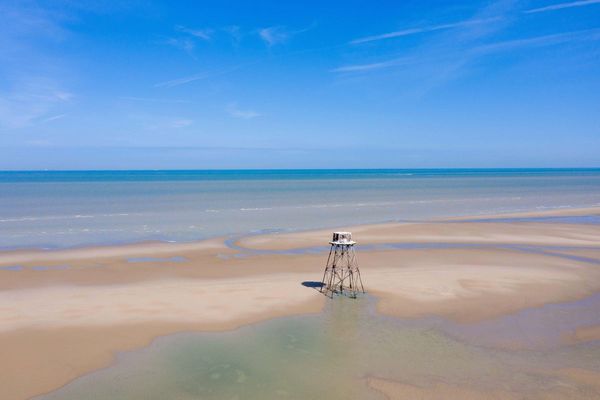MAPLE VALLEY, Wash. _ Standing amid cottonwood trees and a thicket of other vegetation, Jon Hansen looks out over a sunlight-dappled ribbon of crystal water running over a rocky bed. He's standing on a site that until recently was filled with houses and mobile homes _ properties that flooded six times in 20 years when the Cedar River spilled over its banks.
Hansen, the capital project manager for King County, Wash., is showing off the 40-acre site as an example of the county's floodplain restoration _ removing human development rather than engineering bigger and costlier fixes to the flooding that is likely to get worse as a consequence of climate change. The strategy, in other words, amounts to: Get out of nature's way.
"The river has gravity on its side," Hansen said. "Water and gravity will eventually knock down all of these things that we build. It's just a matter of time. As you repair and fix things in a bad place, how long does it take before you say, 'Wait a minute _ why would we spend $2 million (on a levee) to protect a $300,000 home?'"
Buyouts have long been a tool for federal, state and local officials to encourage homeowners to retreat from flood-prone areas. But in the past, buyouts often occurred after major disasters, such as the Missouri River floods of 1993 or Hurricane Floyd in 1999, using investments from the Federal Emergency Management Agency.
Washington is one of the rare states to have its own state-funded buyout and restoration program, one that is set up to remove development from flood-prone areas on an ongoing basis, not just as federal relief money becomes available in the wake of a massive disaster.
Working from lists selected by local partners, the state grant program, established in 2013, pours money into projects that have been identified as subject to persistent flooding. The projects it funds don't just remove vulnerable residents, they enlist nature as an ally. By restoring floodplains to their natural state, they help to lessen the risk of flooding elsewhere.
While the Washington program shows promise, few other states have set up their own dedicated funding for this type of work, even as climate change threatens to worsen flooding in many parts of the country.
"We've really constrained the rivers, and there's just not a place for water to go during flood events," said Bob Carey, the Nature Conservancy's strategic partnerships director, who works closely with the state program, known as Floodplains by Design.
"We're understanding that our historic approach to river management was ineffective," Carey said, "trying to hem rivers in and control flooding, particularly in a changing climate when we're seeing increased volume and frequency. You can't build levees a mile high."
After taking years to buy out and remove nine houses and 55 mobile homes here, King County tore down the levee that had been built along the Cedar River's bank and allowed the river to refill the channel. Already, the small stream has become one of the biggest hotspots for Chinook salmon spawning in the entire Cedar River.
In climate-speak, this strategy is known as managed retreat, removing human development from areas made less habitable by changing conditions. Scientists say managed retreat is crucial to dealing with climate change, particularly as rising sea levels threaten to displace as many as 13 million Americans by 2100.
But despite efforts in Washington and elsewhere, it's clear that new development is far outpacing efforts to get people out of harm's way. On the Jersey Shore, nearly 2,700 homes were built between 2010 and 2016 in areas expected to flood at least annually by 2050, one study by Climate Central and Zillow found. Statewide, another study by the groups showed, more than 4,500 New Jersey homes were constructed during that same period in areas expected to flood about once a decade.
Florida saw more than 2,600 homes built in flood-risk areas during that time, and seven more states exceeded 500 new homes, the study found.
In the year after Hurricane Harvey, 1 in 5 new homes permitted in Houston was in the floodplain. And in South Carolina, unchecked coastal development in the three decades since Hurricane Hugo has left more than 350,000 homes in areas predicted to be at risk of storm surge flooding during a Category 5 hurricane.
Officials often use the term "floodplain" as shorthand for an area predicted to flood during a high-water event that's expected to occur about once a century. Most lenders require homeowners in floodplains to maintain a flood insurance policy.
"The biggest crime we do is we keep rebuilding in the same places," said Peter Kasabach, executive director of New Jersey Future, a nonprofit that advocates for smart growth strategies.
New Jersey's state-run Blue Acres Buyout Program has been hailed as a success story, working toward converting more than a thousand flood-prone properties into open space. The program was launched in 1995, and it was bolstered by an influx of federal dollars in 2012 after Superstorm Sandy. New York also committed hundreds of millions of dollars to buyouts in the wake of Sandy. Still, in many places the retreat has been more than offset by new development, which Kasabach attributed to two factors: lack of funding and lack of political will.
"There is no buyout program that's going to be expansive enough to effectively deal with this issue. There's just not enough money to do that," he said. "And not many mayors say, 'I want to oversee the retreat and dissolution of my town.'"
Buyout programs have not been without their own foibles. An NPR investigation earlier this year found that FEMA buyouts were disproportionately given to white communities with higher property tax values. And not every resident is eager to leave their home. Some feel it's not the government's place to tell them how much risk they should assume, let alone pressure them to relocate.
Local officials have perhaps the most difficult role in managed retreat scenarios, as relocating homeowners and businesses means relocating property and sales tax revenue as well. But floodplain experts note that buyout efforts will be a losing battle if local governments don't also do their part to limit future growth in flood-prone areas.
"One of the real weaknesses of the program is community officials not enforcing their regulations," said Chad Berginnis, executive director of the Association of State Floodplain Managers, a Wisconsin-based coalition of flood hazard specialists. "If they would, we'd break the cycle of damage-repair-damage. Engineered systems will fail, because Mother Nature always builds a bigger storm."
One culprit regularly cited for the status quo is the National Flood Insurance Program, known as the NFIP, which provides insurance through the Federal Emergency Management Agency. Although there's a small private market, the vast majority of flood insurance in the United States is through NFIP. Critics say it has incentivized high-risk development, backstopping builders even after repeated flooding.
About 150,000 "repetitive loss" properties make up just 1% of NFIP policies but more than a quarter of claims. Florida, Louisiana, Texas, New York and New Jersey each have more than 10,000 repeat offenders. Many observers, ranging from members of Congress to analysts in the nonprofit sector, would like to see FEMA put more emphasis on buyouts. The agency's current buyout program lacks the funding and efficiency to be effective, critics say.
"We need to scale (buyouts) up by an order of magnitude if we're going to deal with the problem of sea level rise alone," said Rob Moore, a senior policy analyst with the Natural Resources Defense Council. "The only thing (NFIP) knows how to do is put people back in the same vulnerable situation, at great expense."
Berginnis noted that any effort to step up buyouts will be extremely costly. Even targeting just the 30,000 repetitive loss properties nationwide labeled the most severe, at a cost of hundreds of thousands of dollars apiece, would require billions of dollars. And that doesn't account for the likelihood that climate change will send that number ever higher.
FEMA does conduct some direct buyouts, and it has provided funding for states to do buyouts of their own. But with NFIP paying out repeated claims to frequently flooded properties, many critics think the program is working at cross purposes with attempts to remove risky development.
Not everyone thinks NFIP is a failure. French Wetmore, a floodplain consultant who has worked with communities around the country, noted that the program has reduced flood losses, helped improve building standards and provided a better model than paying flood victims out of disaster relief funds. However, he said FEMA's buyouts could be more effective if the agency moved faster.
"There is flood amnesia. Six months later _ 'What flood?'" he said. "When the community's ready to move and they deal with the public and build a case for it, that's when things have happened. ... More people are buying into the fact that you don't want to go back to normal."
David Maurstad, the FEMA official who oversees NFIP, did not respond to a request for comment.
King County's Cedar River project was completed in 2013, the same year the state launched its Floodplains by Design program. Next year, the county is set to conduct a similar project on a site just downstream, this time bolstered by funding from the state.
King County says it surveyed the residents who were bought out and found they largely felt they were treated fairly and were able to find a better location. Still, in a fast-growing part of the country, with housing already in short supply, taking properties off the map isn't an easy thing to do.
"It takes a lot of political courage to do that," said Helmut Schmidt, a civil engineer in neighboring Pierce County's Floodplain & Watershed Services department. "We're the fastest-growing area in the Western United States. You've got to put those people some place."
Floodplains by Design has thus far funded 36 projects throughout the state, many of which helped relocate residents in high-risk flooding areas. So far, 700 residences have been removed from floodplains as part of the grant program's work. Floodplains by Design has 10 more projects ongoing in the current 2-year budget cycle, funded to the tune of $50 million by the state legislature.
Pierce County is conducting similar projects along the Puyallup River, which spills from a glacier on Mount Rainier before running through industrialized Tacoma and into the Puget Sound. On one 5-mile stretch of the Puyallup, the meandering river was forcing the county to replace a mile of its levee every year, an expensive proposition. If the county can secure buyouts from two remaining holdouts, it will be able to remove some of the levee system and set the river free in the floodplain again.
"This river is young, it wants to move, it doesn't like being pinned," Schmidt said. "We like orderly flow. The river doesn't."
Although the funding has not yet matched the need, Hansen, the King County official, said it's important to recognize that buyouts are a better long-term investment than rebuilding houses and putting in more levees.
"When you build a levee, it doesn't get rid of the flood problem, it shifts it," he said. "Long term, it's a lot more costly to keep doing the same thing when the levees and the houses are in the wrong place."
Several years before King County began work on the Cedar River project, longtime residents Jon and Darlene Miller accepted a buyout and said goodbye to the place they had called home for nearly 40 years. After being flooded twice, the couple was open to relocating when they were approached by local officials.
"I couldn't see how it was going to get any better," Jon Miller said. "We just saw a future where we were going to have to be dealing with that every five years or so. We didn't want to dig our way out from that again."
Since selling the property in 2007, the Millers have seen two flood events that they think would have put their old house underwater. They say they're happy to see the river returning to its natural state, even though they were wistful about leaving their longtime home.







